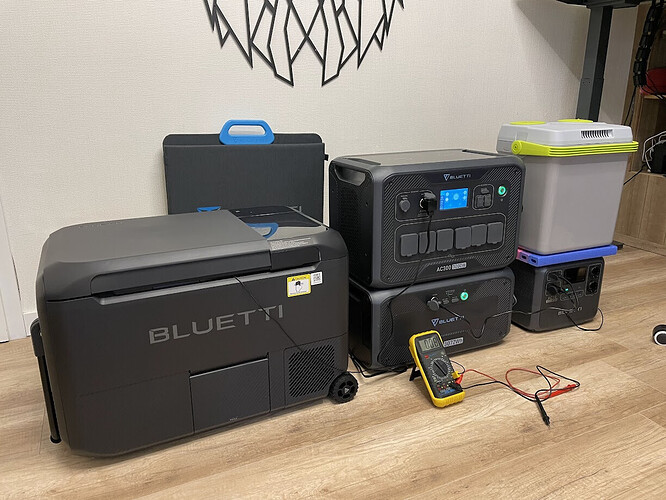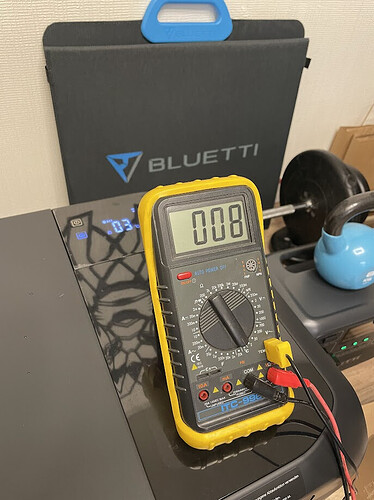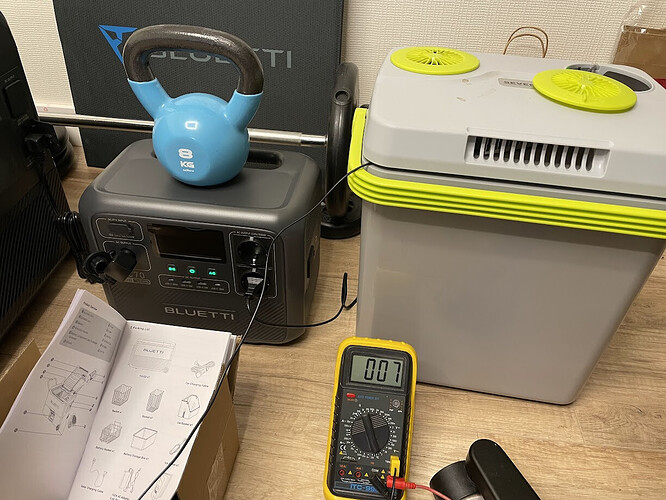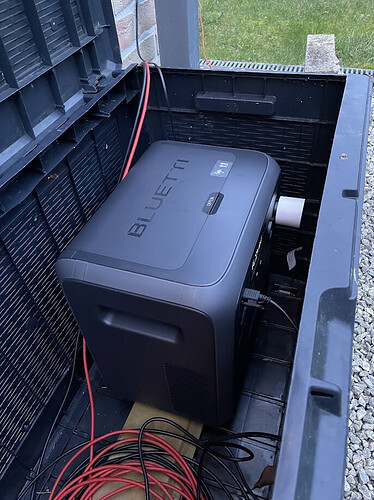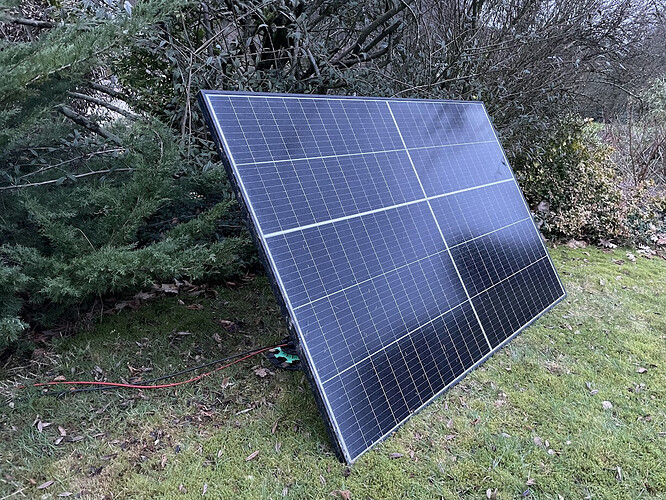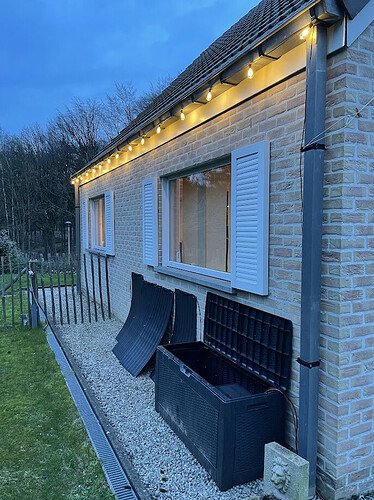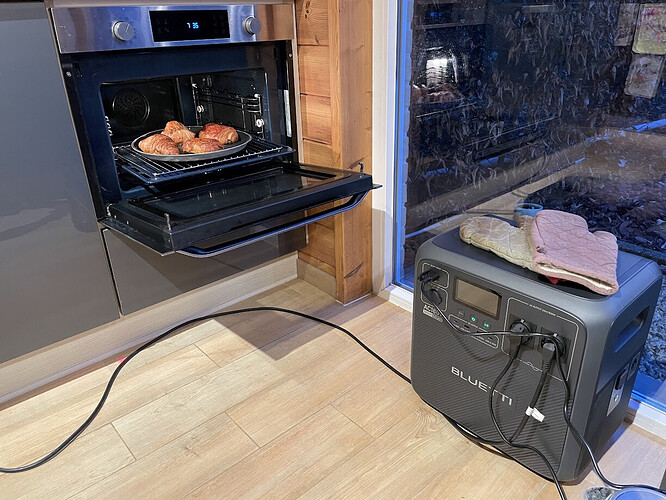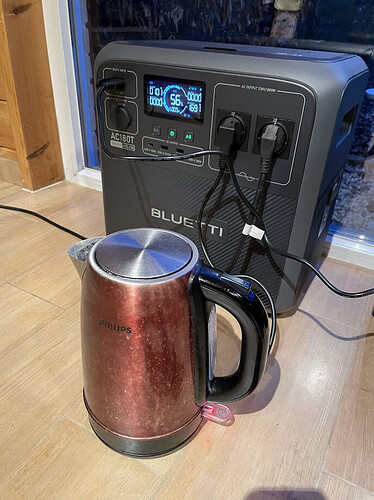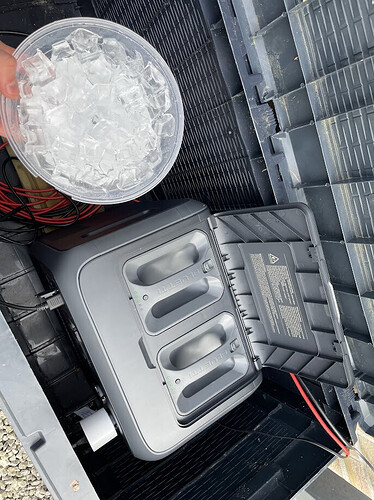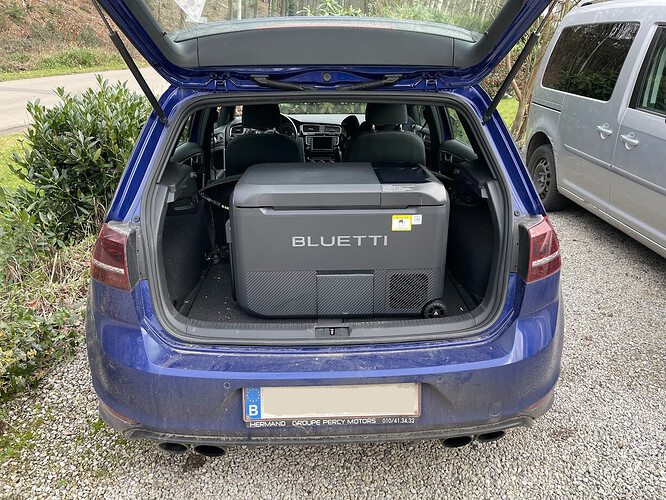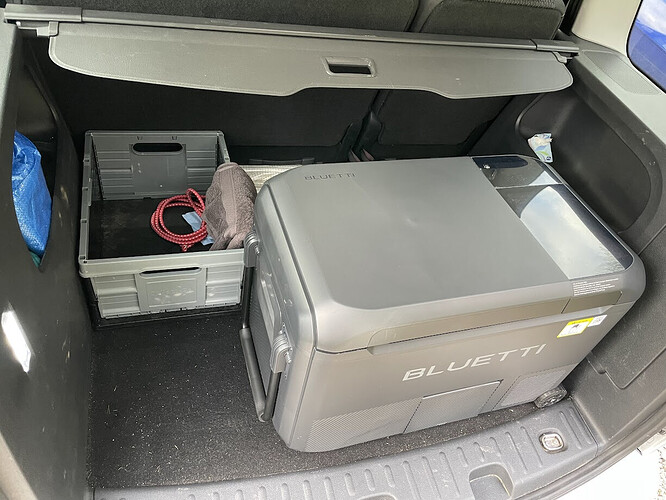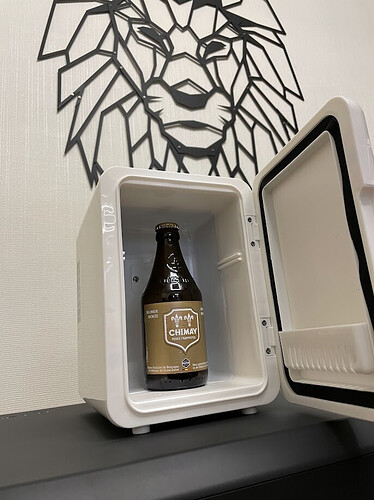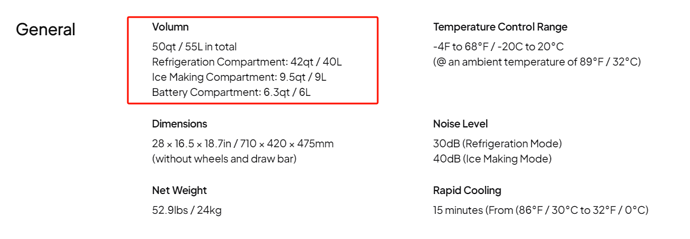TL;DR; aka test results
Conclusions first in case you’d rather skip the details and trivia ![]()
- Measurements during my test showed almost 4.5 days on a single SwapSolar battery, fully packed with water, cruising right above freezing point (1°C / 32°F)
- Energy efficiency and insulation are simply astonishing, keeping food under safe temperature limits for 12 hours without power.
- Long story made short, cordless operation can really make a difference versus devices that don’t have a battery.
- AC180T and its hot-swappable design allowed real 24/7 operation of the fridge with hot-swapping the batteries during peak sun hours. No need for a breaker, or circuit isolator (or blanket to cover the panels…)
- Multicooler will now replace the mid-sized fridge in my office (for lunchtime food & drinks) when not used on vacation, and thanks to it silent operation and low power consumption, it’s good for 365 days a year of operation in an office (or kitchen, of course).
- Ice making can either boost cooling capability (thermal mass, see test 2), or get us hooked on ice tea (instead of coffee). Healthy.
Check the ongoing Indiegogo campagin!
UPDATE: 6 week review verdict
- Strong selling points: power efficiency, insulation.
- Tech feat: AC180T’s hot swapping under load highlights the maturity of the design.
-
Good surprises:
- Ergonomics and transportability of the fridge.
- All-year-round use (indoor fridge, office, very silent & power efficient vs regular 1/2 size fridge).
Original full tests 1 & 2
I’m opposing my trusty 19 liter portable fridge (brand: Severin, gross capacity 19l, realistic capacity 9l) to the Multicooler. Admitedly, they don’t really play in the same category as Multicooler has more than twice the net volume in its main chamber (I managed to store 19 liters of drinks in there, to give an idea of usable capacity without playing Tetris). I bought the Severin fridge as a last minute purchase before going on holiday, and it has both DC (12V) and AC input, so could fit both the car and the hotel room. I wish I had had a Multicooler back then, will try to keep to long story short.
Some eye candy for the other solar nuts among us:
Where is AC180T?
While running this first tests, AC180T is outside, recharging the SwapSolar batteries on a 405W panel so I have a battery ready to test the fridge’s stamina on a single battery.
TEST 1 focuses on energy efficiency versus classic portable fridge.
The first test involved fully loading the fridges with water bottles; that’s about 19 liters for Multicooler and 9 liters for Severin). The Severin is plugged into the DC output of my AC70 so I have an accurate reading while both operate on DC. The Multicooler is on the DC output of AC300 for the same reason. I tested the Multicooler on both 12V and 24V, and can confirm the efficiency is similar regardless of DC voltage.
Test protocol 1 :
- Bottles come from a 10°C basement.
- Set target temperature to 1°C (33°C).
- Observe power consumption during cooling phase.
- Measure internal temperature until it reaches the target temp.
- Observe power consumption when cruising at target temperature.
- Let the fridge operate on DC for 24h to confirm the average power draw.
I’m using a pair of multimeters to keep an eye on the temperature. Note to @Bluetti: the Lifestyle multimeter should feature temp monitoring from now on
I kept myself busy with a good workout (notice the not-so-subtle joke about AC70 doing the “heavy lifting” with an 8kg kettlebell on it… crossfitter humor I guess).
- Multicooler took 2 hours to reach desired temperature (from 10°C/50°F to 1°C/33°F), and had an average consumption of 50-60W during that process.
- Severin took about the same time with 30W draw.
Keep in mind Multicooler has twice the volume of water, so while Severin consumed half of that energy, it’s important to see the consumption per liter of water. In that regard, both performed about equally.
The main difference comes from the Multicooler entering low-power mode when the temperature was reached.
Multicooler cruised as low as 5W to keep things cool in there, while the Severin fridge kept operating at 30W. It is obvious that one was designed to be energy efficient, while the other one was meant to be a cheap quick fix.
- I then left the Multicooler on DC input for 24h and can confirm an average 6-6.5W of power consumption to keep things cool.
- That’s a whopping 4,5 days of autonomy on a single 714Wh, provided the contents were at target temperature when put in the fridge. Those 4.5 days don’t keep the cooling phase into consideration, nor the realistic access to the fridge (open door, take stuff, put other stuff, etc.)
While working in that room (my main office, so I spent at least 9 hours next to it), I could hear the compressor turning on & off every now and then, for very durations. I noticed the compressor only needed to stay on for a few minutes before it could return to low power mode. The multimeter only showed less than 1°C elevation when the compressor turned on, so it’s far from a major variation between pulses.
TEST 2: Insulation
This is where the Severin fridge confirmed being a last-minute bad purchase. Long story made short: we left in the middle of summer for a 6h drive to Puy du Fou (120% recommended to people visiting Europe & France in particular). It was 35°C (95°F) outside on average, and we needed to keep some food cold as my Wife has special dietary needs.
Long story indeed: while the little fridge made it on DC power in the car during the trip, we noticed on day 2 that upon leaving the hotel room, not only would the lights turn off as we removed the keycard from its slot, but it would also disconnect the power plugs. Our little fridge could thus take a 12 hours break and we found its content at room temperature as we returned in the evening. Food inside didn’t like it. We couldn’t leave a 30W device on the car’s battery if we wanted to make it back home at the end of day 3, so we decided Wife would enter fasting mode (ketosis is good fer her ![]() ). Fast forward in February 2024 with a Multicooler, let’s replay this scenario with some serious hardware this time.
). Fast forward in February 2024 with a Multicooler, let’s replay this scenario with some serious hardware this time.
Test protocol 2:
- Now that the power consumption has been tested, we focus on how long it retains the temperature until the 5°C (41°F) ceiling is reached. Above that threshold, the fridge’s temperature allows faster bacteria proliferation*.
(* Harmful bacteria like Salmonella, E. coli, and Listeria are likely to multiply above that threshold… She’s on carnivore diet to reverse a sprouting type-2 diabetes, and she usually lives well on ground beef alone when on the go… long story, made long this time. And for the record, carnivore diet is as efficient as Multicooler, for other things obviously. Speaking of orders of magnitude here. Waffling on here, sorry)
Temperature measurements:
- T0: 1°C (initial temperature)
- 1 hour later: 1.3°C
- +2h: 1.6°C
- +3h: 1.9°C
- +4h: 2.3°C
- +5h: 2.6°C
- +6h: 2.9°C
- +7h: 3.3°C
- +8h: 3.7°C
- +9h: 4.1°C
- +10h: 4.5°C
- +11h: 4.9°C
- +12h: 5.2°C * - this is more than a man-day where insulation alone kept the temp below safe levels.
I read a review that managed to observe a rise from 4°C to 15°C (39°F to 59°F) in 48h, so I wonder how much my multimeter’s wire can have caused a loss in spite of being flat and super thin. I’ll re-test this, not hour after hour, but after 12h, 24h and 48h to see if there is a major difference… For now, I’m noting a +0.25 to +0.4°C per hour which is far from the reading I did with the Severing (from +3 °C to +5 °C per hour). Oh, and to be 100% honest, our hotel room was at 20°C (air conditioning kept working through the day) while my office is usually at 14°C to 16°C (blankets are part of the package if you ask).
Punchline here is that on thermal intertia alone (no power) of a packed Multicooler keeps food safe for more than a full man-day. This means that on top of the previous measurement (4,5 days on a single battery), it can still keep the contents safe for at least half a day more, reaching 5 days of food/medicine safety.
In comparison, Severin already reached 7°C after 2 hours. Different build quality, different target market.
On a side note, when the car’s turned off, its 12V outlets don’t operate at all (VW Caddy, Golf). So even though we WOULD have wanted to operate the fridge, it’d have been impossible, so the cordless operation of Multicooler would have made a huge difference!
TEST 3: 24/7 solar operation - useful 365 days a year?
Ok, this was fun, but let’s move onto serious business: when not on vacation (aka the rest of the year), can I still use my Multicooler, or will it stay in the attic (next to the Severin portable fridge)?
Well, it’s challenging to operate a fridge 24/7 on solar in February, especially given the sort of sun (rather cloudy sky) we have in Belgium (Lat 50°).
While Multicooler is nice and cozy in the office, AC180T is in a garden box, outside, harvesting solar energy from a single 405W panel, S-SW (195°) at 50° tilt (it’s February, can’t tilt higher due to the wind).
(Note to Bluetti: don’t worry, the box closes and it’s waterproof. No AC180T were harmed during the testing)
Test protocol 3:
- Multicooler has 19ish liters of water in it (was thirsty at some point, so much for science) and operates on a SwapSolar battery.
- AC180T recharges the other battery, until it reaches 100%.
- Once AC180T’s battery reaches 100%, the Swap happens.
It’s February, and this panel’s peak sun hours is from 12pm to 4pm. Cloudy skies, milky sun, we’re far from the 1x to 5x the panel’s power to extrapolate theoretical Wh of production. I produced anywhere between 150Wh and 600Wh per day, during the 10 days of testing, for a total of 2.8kWh.
No cliffhanger here, as the math is quick to do:
AC180T harvested almost 200% of the Multicooler’s needs to operate 24/7 on a single 405W panel in sub-optimum solar conditions (February, clouds, etc.)
Regarding hot-swappable batteries. I usually have a blanket to cover a ground-based rooftop panel (can’t fold it unlike PV200), or use a breaker / isolator for longer strings when I need to shut down a unit. Here, under load (tested at 375W of solar input), you safely power off one of the two batteries, and the device keeps running unharmed (ie. it doesn’t shout / beep like an AC300/500 would). It’s designed for it, and it delivers in real life just as expected. This makes me add to my wishlist a more powerful unit (AC200T?) so much this hot-swappable capability is great!
Now, speaking of the extra power it generated. Some was burnt with a Christmas spirit remnant:
And on the 10th day of testing, we even boiled tea water and baked croissants (Bluetti App users will recognize the pic… and yes, @Angelique noticed it was indeed AC180T in spite of the mittens I put on the cover to hide the fact it’s a beta SwapSolar! Kuddos to her keen eye!):
Oh and that kettle is about 2kW, while the oven is 2.2kW, so the PowerLifting test was passed successfully:
Next week, I’ll reorganize the office a little, as I had first planned to buy a half-height kitchen fridge for the co-workers to bring their food. It’s obvious now that the F045D Multicooler has all I need to fill this role. The low power consumption AND low noise (really, I’m sensitive to that) make it an ideal fridge for all-year use. It’s not just a vacation thing, it really replaces a domestic fridge. With 5 seats in the office, we’ll see how well it performs under more realistic load conditions (open fridge, put new stuff that’s a bit warmer, close fridge, make ice, cool down tea, etc.)
Keep you posted on that one.
Fig 10: Solar ice. Aliens observing us from low orbit must think we’re crazy. Solar… ice. Humans, really.
Test 4: Misc
Transportability. I can’t carry much more in my compact hatchback (VW Golf), that’s for sure, unless I only have 1 passenger on the backseat of course:
But in a family / leisure activity vehicle like our Caddy (regular wheelbase), we still have plenty of space, so that summer holiday trip would have been much easier on my Wife’s stomach here:
Adding a grocery box for reference, showing plenty of space in a family vehicle’s trunk:
Speaking of cars (spoiler alert: comic relief).
The batteries have this cool sci-fi factor as stated by another forum member.
Can’t help but see similarities with this “SwapHydrogen” car… of course, a SwapSolar would last 3.5km in an electric car… but then again, please Bluetti, make a SwapSolar eBike!
While in comic territory, we won’t spend too much time comparing Multicooler F045D to the Lifestyle Fridge on the Bluetti store:
It still does great, as it can hold a true Belgian abbey beer. Cheers.
Wishlist for future models and products
- Since I’m mainly using rooftop panels to power my devices, I wish for an AC200T, like a bigger brother with the 145Voc / 1200W solar input of the brand new AC200L. This would make it a fast-charging powerhouse for SwapSolar batteries.
- To make the most of SwapSolar batteries, please bring us the Bluetti eBike suggested by multiple forum users!
- Increase solar input voltage to 58V, so it can use the full range of PV portable panels, just as AC70 can.
- Add wifi/cloud access: in my case, remote monitoring (& receiving alerts) could be useful.
- That solar tracker for a PV200 seems ideal in this context!

